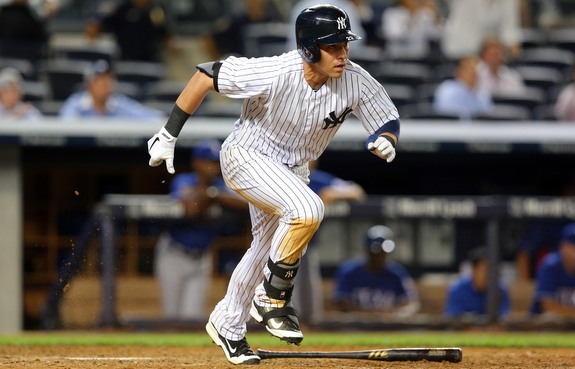
If you’re visiting this website and reading this article, chances are that I don’t need to tell you about the importance of getting on base. You already know that wasting outs is wasting the game and that, generally, the most valuable players in the league are the ones who are best at not making out. You know that the goal of a trip to the plate isn’t necessarily to get a hit, but rather to avoid making an out so you can extend the inning to your teammates and, ideally, extend the game. Allow me to hammer that point home as we examine the top of the order going into 2016.
Barring disastrous injury or some sort of unforeseen shift in philosophy or favor, the Yankees are likely to trot out Jacoby Ellsbury and Brett Gardner–in some order–at the top of their lineup in 2016. Even with the limitations both players have, they are probably the best two options for the one and two spots in the lineup. Gardner and Ellsbury are really carbon copies of each other and their skillsets lend to hitting high in the lineup, though hopefully each player is healthy enough in 2016 to return to his elite bag-swiping level. As important as the middle of the lineup may be and as much as those four players may carry the Yankee offense, the success of that group depends heavily on the success of Gardner and Ellsbury.

To belabor our point from before, the importance of getting on base in baseball can’t be overstated; not only does it keep the game alive, but the effects thereof trickle down to the players below you in the order. For the Yankees, who lack the circular lineup of the 2009-2012 days, this is of most importance to the players hitting one through six. The better table the one-two hitters set, the better meal the four-six hitters will eat.
With the exception of Alex Rodriguez, each of the likely four-six hitters in the 2016 lineup fared better with runners on base in 2015. This is a trend the the league followed. League average OPS with the bases empty was .711 in 2015; with runners on, the league average OPS was .756. Generally, then, hitters OPSed .045 points better with runners on than they did with no runners on. Carlos Beltran (.793 empty to .828 on) was below that league average, but still showed improvement when hitters got on base ahead of him. Mark Teixeira weighed in at an .867 OPS with the bases empty–solid. But when runners were on for him, he jumped up to a .942 OPS, a full 30 OPS points above the league average improvement. The biggest winner of the group, though, was Brian McCann. When McCann came to the plate with nobody on, he hit just .209/.399/.376/.675. During his trips to the plate with men on, however, McCann became a completely different player: .265/.343/.507/.850. His OPS jumped up 175 points. Rodriguez, meanwhile, saw a decline in OPS-based production when runners were on, but that is likely due to the bat being taken out of his hand. In 338 plate appearances with the bases empty, Rodriguez walked 39 times; in 282 PA with men on, he walked 45 times.
The task for Gardner and Ellsbury–at least the task beyond hopefully staying healthy–is simple: do your job and get on base. This same edict will apply to Aaron Hicks and Starlin Castro, other players who may get a shot at the top spots when platooning or when Gardner and Ellsbury get days off. Gardner and Ellsbury are good players, but they are not the ones that will carry a lineup, even at full tilt. The players immediately behind them in the order, that all important middle, will carry the Yankees in 2016. The load will be a lot easier to shoulder if and when Gardy and Taco are on the sacks.
Leave a Reply
You must be logged in to post a comment.